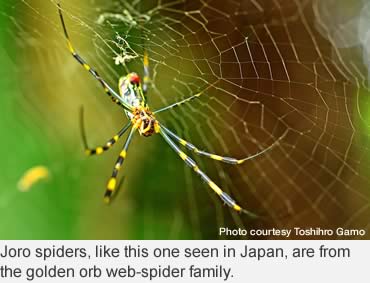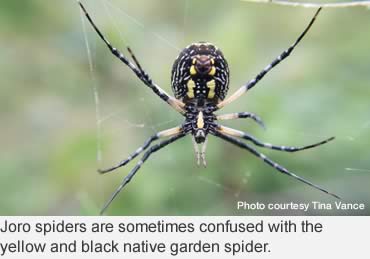Every fall spiders emerge—not only the decorative spiders for Halloween observances, but fascinating, living web-building spiders. But in Georgia, more people are observing a recent arrival to the family of arachnids along their woodland walks and on their back porches—bright yellow-bodied Joro spiders.
They are hard to miss. They're huge, well, for a spider, and so are the webs they build.
Females can grow up to 4 inches long and their massive webs, which appear gold in certain kinds of light, can reach from powerlines to the ground.
When a Joro spider was first spotted in Hoschton, Georgia in 2013, observers realized this was not a super-sized yellow and black garden spider with similar coloration. This was something new.
The Joro spider was colorfully distinctive with its long black legs with yellow-orange stripes, and a bright yellow body with bluish-green stripes on its back and red markings on its underside.
 Richard Hoebeke, a University of Georgia entomologist with the Georgia Museum of Natural History, was the first scientist to identify the alien as the Joro spider. The invasive species, native to China, Korea, Japan and Taiwan, most likely arrived accidentally in container-shipped materials.
Richard Hoebeke, a University of Georgia entomologist with the Georgia Museum of Natural History, was the first scientist to identify the alien as the Joro spider. The invasive species, native to China, Korea, Japan and Taiwan, most likely arrived accidentally in container-shipped materials.
Since that first sighting, the spiders have thrived, and now they’ve been spotted in at least 23 Georgia counties, and across the borders of South Carolina and North Carolina. They haven’t been seen elsewhere in North America.
That means the golden orb-weaving spider has colonized effectively, according to researcher Hoebeke.
Depending on where you live, you might spot one. September through the late November is the time when they are most actively building webs. Females mature in September and are nearing the end of their year-long lifespans by late November.
Most Joro spider webs are three-dimensional with a central orb plus two irregular layers behind it. Webs do not have the zig-zag pattern of the garden spider, also called writing spiders.
It’s too soon to know what impact they are having on native spiders. Dr. Mattias Johansson, an assistant professor of biology at the University of North Georgia who studies Joro spiders, believes it’s possible the spider is outcompeting their native neighbors and are affecting the larger insect community.
“There are only so many and they’re so big,” he said. “They must be processing a fair bit of prey to get that size and become that numerous.” The number and the spread suggest the species is here to stay.
 Joro spiders appear to be coexisting with other orb weaving spiders, and researchers have noted they capture and feed on one invasive pest native spiders do not—the invasive adult marmorated stink bug that can infest houses and damage crops. Joro spiders are vulnerable to mud dauber wasps and birds.
Joro spiders appear to be coexisting with other orb weaving spiders, and researchers have noted they capture and feed on one invasive pest native spiders do not—the invasive adult marmorated stink bug that can infest houses and damage crops. Joro spiders are vulnerable to mud dauber wasps and birds.
Dr. Johansson has led biology student research teams to study Joro spider prevalence and effect on the ecosystem. Although the species is venomous—as are all spiders—it is not considered dangerous and is “actually pretty sedentary,” he said.
Spider observers can become citizen scientists and assist researchers who are looking to find Joro spider locations. Especially helpful is providing a photo tagged with the date and location where the spider was seen, then emailing it to Richard Hoebeke at rhoebeke@uga.edu.
Not sure what you’re seeing? Confirm your guess by downloading the free iNaturalist mobile app available as iOS or Android.
– Resources: Georgia Department of Natural Resources, University of Georgia Museum of Natural History, University of North Georgia.